unit7----It's-raining!教学设计
- 格式:docx
- 大小:25.46 KB
- 文档页数:12
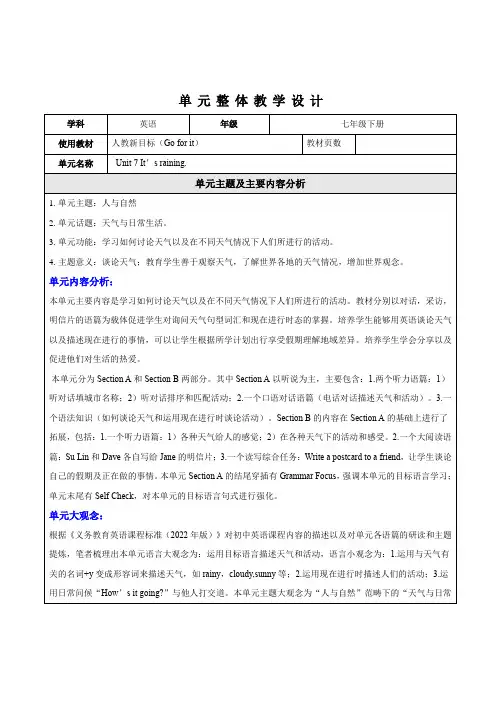
单元整体教学设计
活动”。
通过整合,笔者将Section A 1a-1c作为第一课时,提炼课时子主题为“世界主要国家与城市的天气”;将Section A 2a-2d和Section B1a-1e作为第二课时,提炼课时子主题为“同伴交往与文化自信”;将Grammar Focus-3b作为第三课时,提炼课时子主题为“生活与学习”;将Section A 2a-2d及Section B 1a-1e 作为第四课时,提炼课时主题为“不同生态地区的生态特征与自然景观”。
此外,笔者还增加了两篇拓展阅读材料和一个综合实践任务,作为第五课时,提炼课时主题为“热爱与敬畏自然,与自然和谐共生”。
单元主题框架结构图如下:
单元核心语篇分析:。

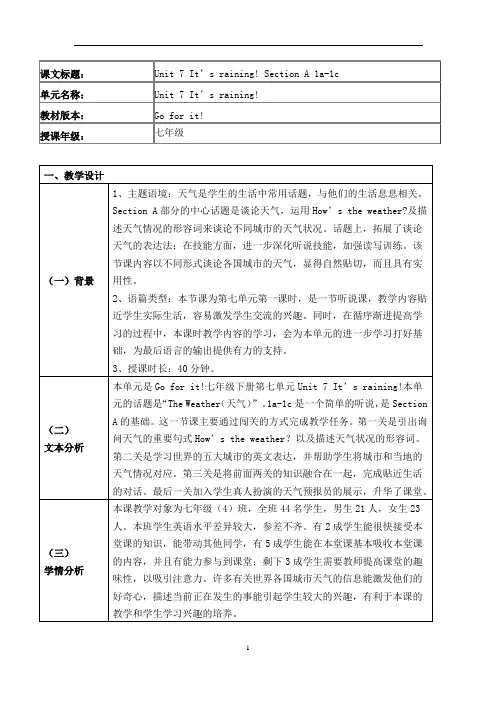
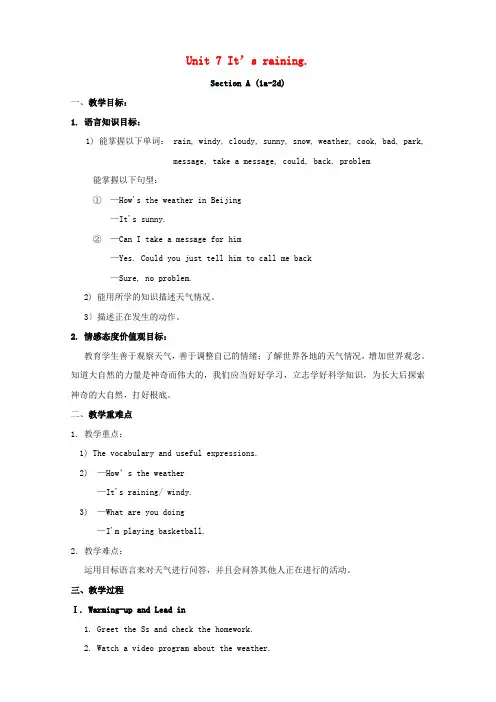
Unit 7 It’s raining.Section A (1a-2d)一、教学目标:1. 语言知识目标:1) 能掌握以下单词: rain, windy, cloudy, sunny, snow, weather, cook, bad, park,message, take a message, could, back, problem 能掌握以下句型:①—How's the weather in Beijing—It's sunny.②—Can I take a message for him—Yes. Could you just tell him to call me back—Sure, no problem.2) 能用所学的知识描述天气情况。
3〕描述正在发生的动作。
2. 情感态度价值观目标:教育学生善于观察天气,善于调整自己的情绪;了解世界各地的天气情况,增加世界观念。
知道大自然的力量是神奇而伟大的,我们应当好好学习,立志学好科学知识,为长大后探索神奇的大自然,打好根底。
二、教学重难点1. 教学重点:1) The vocabulary and useful expressions.2) —How’s the weather—It's raining/ windy.3) —What are you doing—I'm playing basketball.2. 教学难点:运用目标语言来对天气进行问答,并且会问答其他人正在进行的活动。
三、教学过程Ⅰ. Warming-up and Lead in1. Greet the Ss and check the homework.2. Watch a video program about the weather.Ⅱ. Presentation1. (Show some pictures of the weather)Let Ss look at the pictures and ask them how the weather is.Ss learn the new words and expressions with the help of the pictures.2. Look at the pictures in 1a. Then read the new words on the right. Ask the Ssto match the words with pictures.3. Check the answers.Ⅲ. Game (How's the weather)1. (Showing some pictures on the big screen.) Ask Ss "How's the weather"2. Ss guess and answer the question.Ⅳ. Listening1. Now let's look at the city names in the box in 1b. Please read after me.Ss read the cities after the teacher.2. Now, We’ll hear four conversations. Listen carefully, point out each city inthe picture as it comes upon the tape. Play the recording a second time. Ask Ss to write the name of the city in the picture of its weather.3. Check the answers.Ⅴ. Pair work1. Tell the Ss: If you are in one of the places in the picture above. Talk aboutthe weather with your friends in another city on the phone.2. Make a model with a student like this:T: Hi! How's the weather in BeijingS1: It's sunny.3. Ss work in pairs. Ask and answer about the weather in the cities.Ⅵ. Listening1. Work on 2a.Let's see what Joe's families are doing. Point to the 4 pictures .2.Ask Ss tell each person is doing in each picture. More attention s should be paidto the correct use of the Present Progressive Tense.3. Play the recording for the Ss to listen and number the pictures [1-4].4. Play the tape for Ss to check the answers.5. With the whole picture, get some Ss to tell the story of it.6. BrainstormingPlay the tape for another time. Then do a memory test.Ask Ss: What's Uncle Joe/Jeff/Mary/Aunt Sarah doingWhat're Scott and Lucy doingIs Jeff watching TV etc.7. Let Ss match the names with the activities in 2b.Play the recording for the Ss to check the answers.Ⅶ. Pair work1. Look at the pictures and talk about the people in 2a with a partner.2. Ask a student the questions as a model:T: What's Uncle Joe doingS1: He's playing basketball.3. Ss work in pairs. Ask and answer about the pictures.Ⅷ. Role-play1. Ask Ss to read the conversation and answer the questions:① What's Steve doing② What's Rick's brother doingSs read the conversations and answer the questions. Then check the answers together.2. Let Ss role-play the conversation in pairs.IX. Language points.X. ExercisesHomework:一、总结有关天气的词汇。
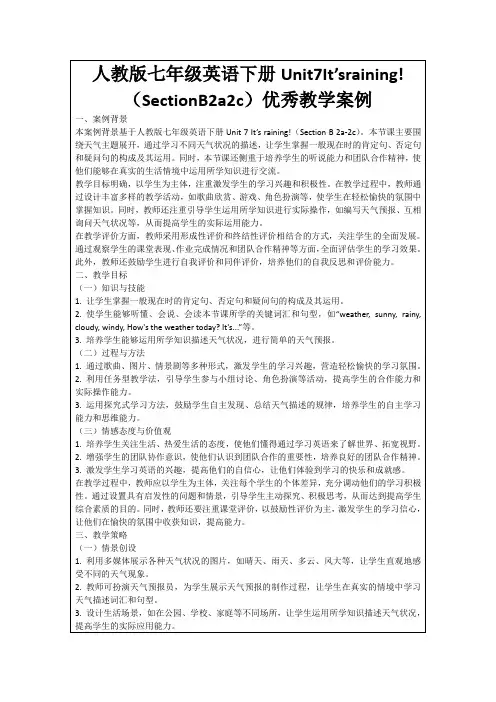
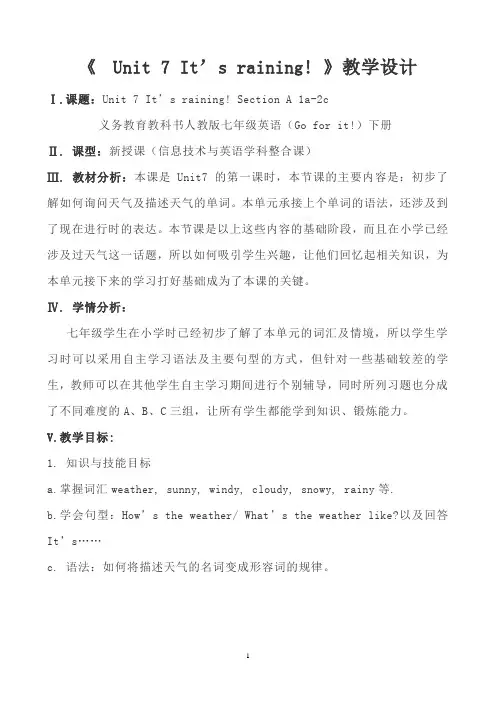
《Unit 7 It’s raining! 》教学设计Ⅰ.课题:Unit 7 It’s raining! Section A 1a-2c义务教育教科书人教版七年级英语(Go for it!)下册Ⅱ. 课型:新授课(信息技术与英语学科整合课)Ⅲ. 教材分析:本课是Unit7 的第一课时,本节课的主要内容是:初步了解如何询问天气及描述天气的单词。
本单元承接上个单词的语法,还涉及到了现在进行时的表达。
本节课是以上这些内容的基础阶段,而且在小学已经涉及过天气这一话题,所以如何吸引学生兴趣,让他们回忆起相关知识,为本单元接下来的学习打好基础成为了本课的关键。
Ⅳ. 学情分析:七年级学生在小学时已经初步了解了本单元的词汇及情境,所以学生学习时可以采用自主学习语法及主要句型的方式,但针对一些基础较差的学生,教师可以在其他学生自主学习期间进行个别辅导,同时所列习题也分成了不同难度的A、B、C三组,让所有学生都能学到知识、锻炼能力。
V.教学目标:1. 知识与技能目标a.掌握词汇weather, sunny, windy, cloudy, snowy, rainy等.b.学会句型:How’s the weather/ What’s the weather like?以及回答It’s……c. 语法:如何将描述天气的名词变成形容词的规律。
2. 过程与方法教师制作主题网站,让学生通过主题学习网站学习单词并检验、观看视频学习语法、听英语歌曲拓展知识等方式,掌握需要学会的单词、句型及语法。
3. 情感态度与价值观让学生在自主学习的过程中体会成功的快乐,并在自评和互评的过程中学会客观看待事物。
VI.教学重难点:如何描述天气。
VII. 教学方法手段:本节课主要运用了计算机辅助教学,充分利用了网络环境下信息技术与英语学科的整合,穿插了学生对话、网上练习等多种方式。
VIII.教学过程Ⅸ.板书设计Ⅹ.教学流程图。
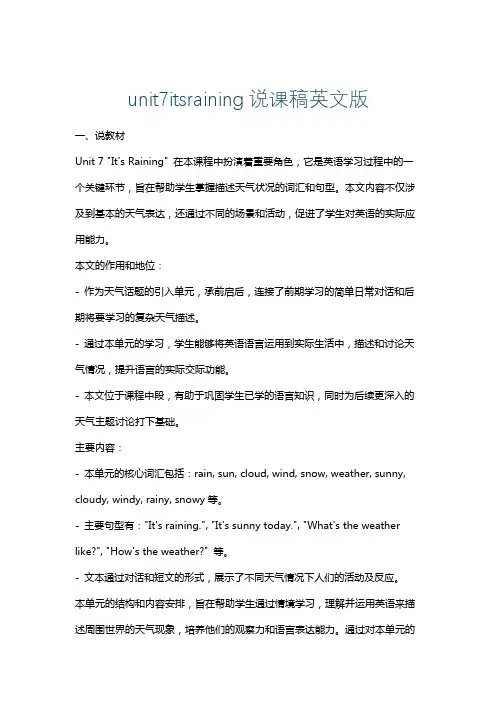
unit7itsraining说课稿英文版一、说教材Unit 7 "It's Raining" 在本课程中扮演着重要角色,它是英语学习过程中的一个关键环节,旨在帮助学生掌握描述天气状况的词汇和句型。
本文内容不仅涉及到基本的天气表达,还通过不同的场景和活动,促进了学生对英语的实际应用能力。
本文的作用和地位:- 作为天气话题的引入单元,承前启后,连接了前期学习的简单日常对话和后期将要学习的复杂天气描述。
- 通过本单元的学习,学生能够将英语语言运用到实际生活中,描述和讨论天气情况,提升语言的实际交际功能。
- 本文位于课程中段,有助于巩固学生已学的语言知识,同时为后续更深入的天气主题讨论打下基础。
主要内容:- 本单元的核心词汇包括:rain, sun, cloud, wind, snow, weather, sunny, cloudy, windy, rainy, snowy等。
- 主要句型有:"It's raining.", "It's sunny today.", "What's the weather like?", "How's the weather?" 等。
- 文本通过对话和短文的形式,展示了不同天气情况下人们的活动及反应。
本单元的结构和内容安排,旨在帮助学生通过情境学习,理解并运用英语来描述周围世界的天气现象,培养他们的观察力和语言表达能力。
通过对本单元的学习,学生将能够更加自信地参与到天气话题的讨论之中。
四、说教法在教学Unit 7 "It's Raining" 时,我计划采用多种教学方法,以确保学生能够积极参与并有效掌握课程内容。
以下是我将采用的一些关键教学方法及其亮点:1. 启发法(Heuristic Approach):- 我将通过提问引导学生思考,激发他们的好奇心和探究欲。
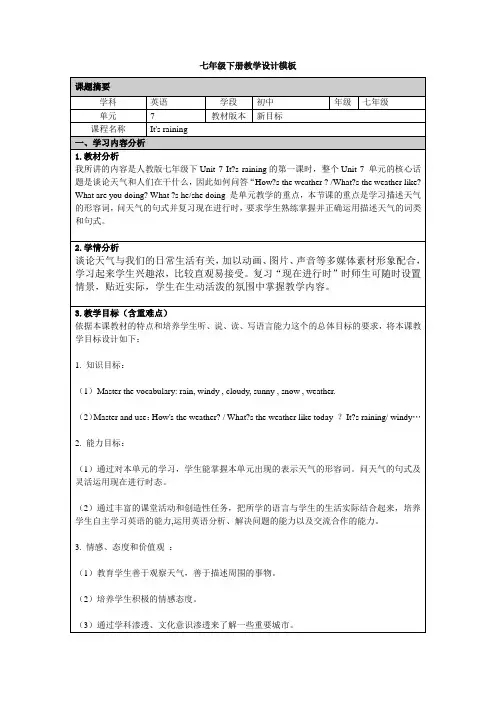
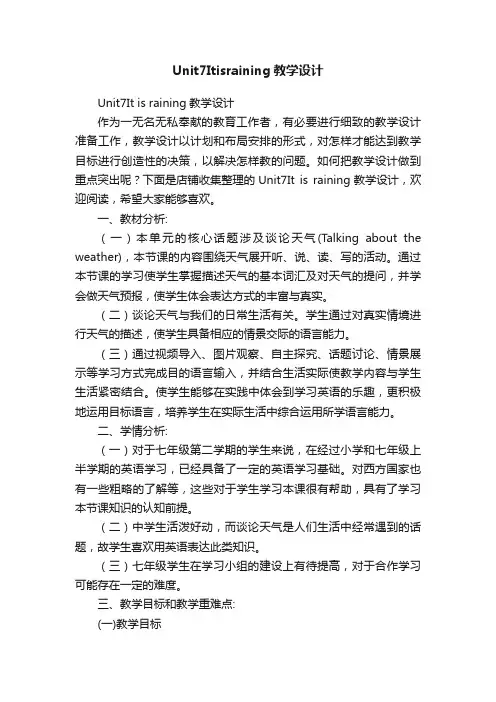
Unit7Itisraining教学设计Unit7It is raining教学设计作为一无名无私奉献的教育工作者,有必要进行细致的教学设计准备工作,教学设计以计划和布局安排的形式,对怎样才能达到教学目标进行创造性的决策,以解决怎样教的问题。
如何把教学设计做到重点突出呢?下面是店铺收集整理的Unit7It is raining教学设计,欢迎阅读,希望大家能够喜欢。
一、教材分析:(一)本单元的核心话题涉及谈论天气(Talking about the weather),本节课的内容围绕天气展开听、说、读、写的活动。
通过本节课的学习使学生掌握描述天气的基本词汇及对天气的提问,并学会做天气预报,使学生体会表达方式的丰富与真实。
(二)谈论天气与我们的日常生活有关。
学生通过对真实情境进行天气的描述,使学生具备相应的情景交际的语言能力。
(三)通过视频导入、图片观察、自主探究、话题讨论、情景展示等学习方式完成目的语言输入,并结合生活实际使教学内容与学生生活紧密结合。
使学生能够在实践中体会到学习英语的乐趣,更积极地运用目标语言,培养学生在实际生活中综合运用所学语言能力。
二、学情分析:(一)对于七年级第二学期的学生来说,在经过小学和七年级上半学期的英语学习,已经具备了一定的英语学习基础。
对西方国家也有一些粗略的了解等,这些对于学生学习本课很有帮助,具有了学习本节课知识的认知前提。
(二)中学生活泼好动,而谈论天气是人们生活中经常遇到的话题,故学生喜欢用英语表达此类知识。
(三)七年级学生在学习小组的建设上有待提高,对于合作学习可能存在一定的难度。
三、教学目标和教学重难点:(一)教学目标1.知识与技能目标掌握询问天气的表达方式及天气的形容词rainy –raining、snowy—snowing 等,并且能够运用所学的句型完成各种语言任务。
2.过程与方法目标依托本单元的语言素材提高学生听、说、读、写能力。
培养学生善于听说、乐于听说的良好习惯和学习能力。
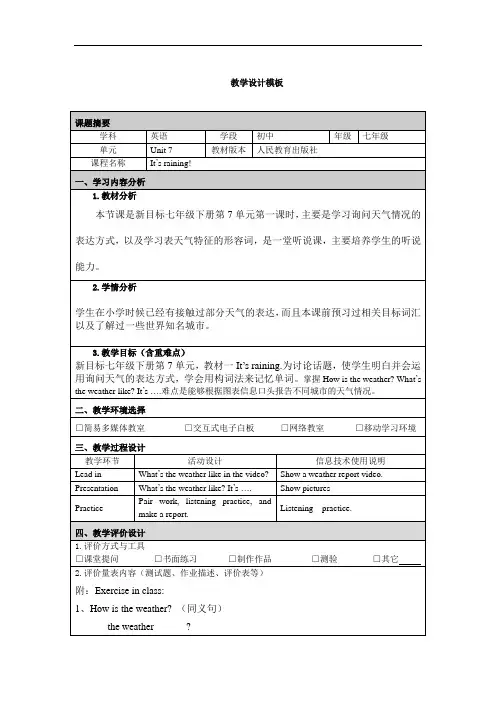

贵阳七中谭敏Step 2 Lead-in1. Guide the students to watch the video, and pay attention to the weather.It’s also a small game.2. Present videos/pictures of different weather and people are doing different things in the pictures . All the students watchthe video and one ofthem click the button according to the video.Students work in pairsto talk about theweather and whatpeople are doing in the pictures.引出话题。
复习目标语言。
Step 3 Pre-reading1. Present the new words:visit, Canada, summer, sit, juice, soon, vacation, hard, Europe, mountain, country2. 2aAsk students to look at the screen and talk about the pictures (in 2a) with a partner.Make a model to the Ss.S1: How's the weather in picture a?S2: It's sunny and warm.S1: What's the girl doing?S2: She's sitting near the pool and drinking some juice. Look at the pictures ofnew words on screenand learn the newwords.Students work in pairsand talk about thepictures. How’s theweather?What are the peopledoing?通过图片教授新单词。
Period 1 Unit 7 It’s raining !(Section A 1a-1c)Teaching aims1. Words : weather, sunny, windy, cloudy, rainy, snowy2. Can use the structures:--How is the weather in...? ---It's ...Ability Objects:1.Train students’listening and speaking skills.2. Train studets’ability of understanding.Teaching Key Points:1.Key phrase.2.Target language.Teaching Difficulties:Master the key sentence structureTeaching Procedures:Step 1. Warming-up and Lead-in1. Let Ss listen to a song “Rhythm of the rain”2. T: Do you like this song?T: Do you know the song? Ss: 雨中旋律T: Yes. What kind of sound do you hear in this song?Ss: 打雷,下雨3. T: Yes. It’s raining in this song. Today we’ll learn Unit 7. It’s raining.Step 2. Presentation1. Show some picturesT: What’s this in English? (It’s the sun.)2. Then show some other pictures.T: How’s the weather in the picture?Ss: It’s sunny.(In the same way, finish teaching the words “sun, cloud, wind, rain, snow”“windy, cloudy, raining, snowing”)Step 3 Play a songLet Ss try to find the answers to the two questions.How many kinds of weather are there in the song?What are they?Step 4 work on 1a1. Show some signs of the weather to the students and get them to know the signs.2. teacher ask and students answer “How’s the weather? It’s...”(Show more pictures about the weather in different places)T: Look, how’s the weather in..? Ss: It’s raining in ....T: How’s the weather in ...? S1: It’s cloudy in ....3.Ask students to match the words with the picturesStep 5. Listening1b. Listen and write these city names in the boxes above.(Before listening, show pictures of the five cities and teach the places. Get Ss to familiar with these places.Step 6. Pair work1c. Imagine you are in one of the places. Talk about the weather with your partner on the phone.A: Hi! How’s the weather in the Beijing?B: It’s sunny.Step 7. Weather reportShow a map of China. Ask Ss to talk about the weather in some cities in China. Report: Good morning. Here is CCTV weather report. It’s…in Beijing. It’s…in Guangzhou. It’s…in Shanghai. And it’s…in Ningbo. Thank you.Step 8 Summarize and homework.Period 2 Unit 7 It’s raining !(Section A 2a-2d)Teaching aims1. Words : cook, bad, park, message, take a message, could, back, problem2. Can use the structures:--How is the weather in...? ---It's ...What are you doing? --I'm playing basketball.What is he doing? --He is playing basketball.--Can I take a message for him? --Yes. Could you just tell him to call me back? --Sure, no problem.Ability Objects:1.Train students’listening and speaking skills.2. Train students’ability of understanding.Teaching Key Points:1.Key phrase.2.Target language.Teaching Difficulties:Master the key sentence structureTeaching procedures:Step1 warm up.Watch a video, ask and answer :T: Hi! How's the weather ?S1: It's sunny. ...Step 2 presentation:Show the pictures and ask and answer:How's the weather ? S1: It's sunny. ...What are they doing on a sunny day? They are running.(Learn the other language in the same way.)Step 3 Work on 2a.1. Let's see what Joe’s families are doing. Point to the 4 pictures.2. Ask Ss tell each person is doing in each picture. More attentions should be paidto the correct use of the Present Progressive Tense.3. Play the recording for the Ss to listen and number the pictures [1-4].4. Play the tape for Ss to check the answers.5. With the whole picture, get some Ss to tell the story of it.6. Let Ss match the names with the activities in 2b.Play the recording for the Ss to check the answers.7. BrainstormingPlay the tape for another time. Then do a memory test.Ask Ss: What's Uncle Joe/Jeff/Mary/Aunt Sarah doing?What’re Scott and Lucy doing?Is Jeff watching TV? etc.Step 4 Pair work .1. Look at the pictures in 3b and talk about the people with a partner.2. Ask a student the questions as a model:T: Hi! How's the weather ?S1: It's sunny. ...T: What's he doing on a sunny day?S1: He's playing the guitar.3. Ss work in pairs. Ask and answer about the pictures.Step 5. Role-play.1. Ask Ss to read the conversation and answer the questions:①What's Steve doing?②What's Rick's brother doing?What does Steve want Rick’s brother to do?Ss read the conversations and answer the questions. Then check the answerstogether.2. Let Ss role-play the conversation in pairs.Step 6. Self Check 21.Read the sentences below on the left and find the responses on the right.2. Ss read the sentences below and find the responses.3. Check the answers with the class. Then let the Ss practice the conversation witha partner.Step 7. Language points.Step 8 . ExercisesStep 9. Homework:Section A (2a-2d)How's the weather ? S1: It's sunny. ...What are they doing on a sunny day? They are running.What is he doing on a cloudy day? He is swimming.Period 3 Unit 7 It’s raining !(Section A 2a-2d)Teaching aims1. Words : again2. Can use the structures:How’s the weather? --It’s cloudy./ It’s sunny./ It’s raining.What are you doing? --I’m cooking.What are they doing? --They’re playing basketball in the park.What’s he doing? --He’s studying in his friend’s home.—How's it going? —Great! / Not bad./ Terrible.Ability Objects:1.Train students’ speaking skills.2. Train students’ability of understanding.Teaching Key Points:1.Target language.Teaching Procedures:Step 1. Warming- up and revision.1. Have a dictation of the new words and expressions in period 1.2. Ask some pairs to role-play the conversation in 2d.Step 2 . Grammar Focus.1. 学生阅读Grammar Focus中的句子,然后做填空练习。
unit7 it is raining教案(一)教案:Unit 7 It is Raining教学目标•能够用英语表述天气情况•能够使用句型“It is raining”来描述下雨天气教学重点•掌握句型“It is raining”•熟悉下雨天气的表达方式教学难点•掌握天气情况的不同表达方式教学准备•PPT或黑板教学步骤1.宣布今天的授课内容是关于天气的表达方式2.引言,让学生说一下自己对天气的印象3.展示图片或视频,形象地表达下雨的情况4.教授句型“It is raining”并发音练习5.展示下雨天气的其他表达方式:rainy, wet, damp等6.让学生模仿句型并加入其他表达方式进行练习7.复习句型和表达方式课堂练习•完成题目填空:_______ raining outside. (It is)•练习搭配其他表达方式:Today is very _______.(rainy/wet/damp)教学扩展•制作关于不同天气情况的PPT并讲解•探究当地的天气变化及其不同表达方式课后作业•写一篇约50词的作文描述今天的天气,并使用It is raining 这个短语。
•积极观察天气变化并尝试不同的表达方式教学反思本节课的教学注重口语练习和实用性,让学生能够在日常生活中轻松表述天气情况。
在教学中应注意示范和练习的多样性,以便学生更好地掌握。
同时,对于天气表达方式的多样性也需要逐步引导学生学会。
教案:Unit 7 It is Raining (续)资源分享•可以使用Quizzizz等工具进行天气表达方式的测验•有关天气的歌曲、童谣等可以加入教学中进行引导和练习注意事项•在天气词汇的教学中,要注意区分大小写、单复数及时态等•让学生意识到天气语言环保之重要性,鼓励使用自然语言表述天气情况课堂评估•以小组讨论的方式,让学生讲述自己喜欢的天气,使用多样化的表达方式•在教学中不断进行问题解答,看学生是否掌握了相关知识点教学延伸•可以引导学生在日常生活中多关注天气,增强天气观察能力•可以组织学生进行天气拍摄、天气报告等活动,提高学生的实践能力和语言表达能力教学的意义•在天气多变的环境中,掌握天气表达方式有着非常重要的实用性•通过这个教学,可以切实提高学生的英语口语能力和实践能力•天气教学还能引导学生关注环保、适应自然等方面的思考教学反馈•在教学后,可适当进行学生的问卷调查,了解学生对于教学内容、教学方法的反馈•班级教学沙龙是个交流的好地方,可以让同事来听你的课,互相分享教学心得,以便提高教学质量。
Unit7 It’s raining.Section B 3a-3cⅠ教学目标1、语言目标(1) Learn some new words and phrases: skate,snowy,winter,Russian,snowman,rainy, have fun,take a photo(2) Learn some important sentences:①Where are you?②What’s the weather like?③What are you doing right now?④Are you having a good time?2、能力目标能运用目标语言对天气情况进行描述及对正在进行的活动进行描述。
3、情感目标学会谈论天气,热爱自然,增进与他人之间的交流。
4、教学重难点1.现在进行时态的使用。
2.天气的描述。
5、教学过程Step1 Greeting and revision1.Greeting2.T instructs students to review the weather and what people are doing by the pictures:T: How’s the weather?Ss: It’s sunny.T: What’s he doing?Ss: He’s swimming.Step2 Leading in and presentation1.T instructs students to look some pictures about Harbin’s winter, and guess what people are doing.2.Students learn some new words by the pictures.3.Students read the words and after T. Then they read them together.Step3 Reading1.T asks students to read the words in the box.2. Students read the passage and fill in the blanks with the words.3. T checks the answer.4. T asks students to read the passage aloud.4.T leads students to think: how to write a postcard to tell your friend about your vacation.Step4 Writing1.T asks students to imagine they are on vacation in Sanya .Write notes about their vacation according to the questions in 3b.Where are you?What’s the weather like?What are you doing right now?What are your friends or family doing?Are you having a good time?2.Students write their passages with the pictures,words, and phrases.3.T checks some students’ passages.Step5 SummaryHow to write about a vacation?Step 6 HomeworkWrite a vacation to a friend .板书设计Unit 7 It’s raining.Section B 3a-3cskate 滑冰snowy 下雪的winter 冬天Russian 俄罗斯的,俄罗斯人snowman 雪人rainy 多雨的。
贵阳七中谭敏
correct picture in 2a.
Then check the answers.
2. Careful reading:
Read the first postcard again and find the answers to these questions.
① Where is Su Lin now?
② What is Su Lin studying here?
③Is she visiting some of his old friends there?
④What’s she doing right now?
⑤How’s the weather there?
Read the second postcard again and find the answers to these questions.
① Where is Dave now?
②What are Dave and his family doing there?
③Are they having a good correct picture.
Then check the answers
with partner.
Students read the
postcards and try to
find the answers to the questions.
Then check the answers
in groups of four.
之相符的图
片。
让学生与同
桌先核对再
全班核对。
能够根据文
中细节内容
迅速找出与
问题的答
案。
让学生先在
四人小组内
核对再全班
核对。
time?
④How’s the weather there?
⑤How’s the weather in Jane’s country?
Then check the answers in class.
Step 5 Post-reading
1. Read the postcards again and fill in the chart with the information from the postcards in 2b.
2.Read the postcards and underline the sentences with “be V-ing” and “weather”.
3.Ask students to pay attention to the three parts of the postcards.
➢Greening
➢Main part (what you
are doing and how Read the postcards and
finish 2b.
Read the postcards and
underline the target
languages.
pay attention to the
three parts of the
postcards and find them
out.
通过完成
2c梳理文
章的重要信
息,并未下
面一个任务
做好铺垫。
引起学生对
目标语言的
关注并且梳
理出相关句
型为下次课
的写作表达
做准备。
引起学生对
明信片文体
的关注,为
下次课的写
作表达做准
备。